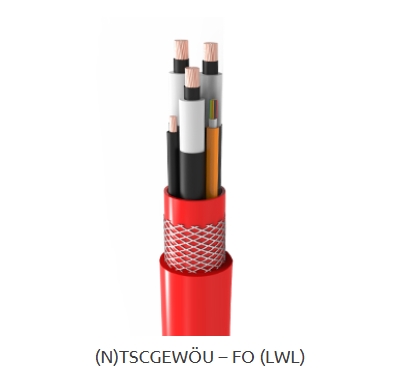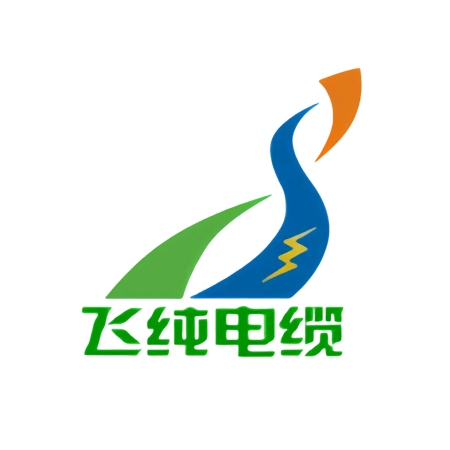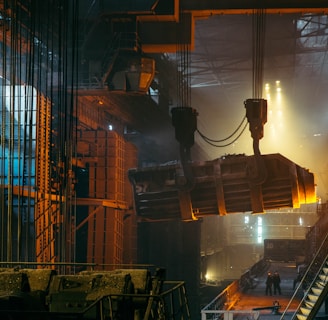Why (N)TSCGEWÖU – FO (LWL) Is the Ultimate Marine and Industrial Cable Solution for Mission-Critical Applications
Discover why (N)TSCGEWÖU – FO (LWL) cable combines medium voltage power delivery with optical fiber communication in one robust solution, engineered for demanding marine, mining, and port operations.
BLOGS
6/17/202510 min read


Introduction: The Evolution of Industrial Cable Technology
In today's rapidly advancing industrial landscape, engineers and procurement specialists face an increasingly complex challenge: finding cable solutions that can simultaneously deliver reliable power and high-speed data transmission while withstanding the harshest environmental conditions. The (N)TSCGEWÖU – FO (LWL) represents a significant breakthrough in this regard, offering a sophisticated medium voltage flexible power and control cable specifically engineered for heavy-duty applications in mining, tunneling, material handling, and maritime operations.
This innovative cable system fundamentally changes how we approach infrastructure design by combining power delivery and optical fiber data transmission within a single, exceptionally robust construction. Rather than requiring separate power and communication cables, this integrated solution simplifies installation, reduces maintenance requirements, and provides superior performance in automated machinery and control systems where both energy distribution and real-time data communication are essential.
The significance of this technology becomes particularly apparent when we consider the operational demands of modern port facilities, mining operations, and marine environments. These applications require cables that can endure constant movement, extreme temperature variations, exposure to oils and chemicals, and mechanical stresses that would quickly destroy conventional cable systems. The (N)TSCGEWÖU – FO (LWL) addresses each of these challenges through its sophisticated multi-layer construction and carefully selected materials.
Critical Applications: Where Performance Meets Extreme Demands
Understanding the specific applications where (N)TSCGEWÖU – FO (LWL) excels helps illuminate why its unique design features are so essential. This flexible composite cable demonstrates exceptional performance across a range of challenging industrial environments, each presenting distinct operational requirements that conventional cables simply cannot meet.
Marine and Port Operations
In marine applications, particularly in large port facilities, the cable serves as the backbone for massive container cranes, ship-to-shore gantry cranes, and automated stacking systems. These applications demand cables that can handle both the substantial power requirements of heavy lifting equipment and the high-speed data transmission needed for precise positioning and automated control systems. The constant movement of these cranes, combined with exposure to salt air, temperature fluctuations, and potential chemical exposure, creates an environment where cable reliability directly impacts operational efficiency and safety.
Port operations also utilize festoon systems, where cables must travel horizontally along tracks while supporting their own weight and maintaining electrical integrity. The (N)TSCGEWÖU – FO (LWL) cable's ability to operate at horizontal travel speeds up to 200 meters per minute while maintaining both power delivery and data transmission capabilities makes it ideally suited for these demanding applications.
Mining and Tunneling Equipment
Underground mining operations present perhaps the most challenging environment for cable systems. The combination of mechanical stress, temperature extremes, potential exposure to corrosive substances, and the need for reliable communication between surface control systems and underground equipment creates requirements that few cables can meet. Mining equipment such as continuous miners, longwall systems, and conveyor installations require cables that can withstand constant flexing, potential impact damage, and the harsh chemical environment often found in mining operations.
The integration of optical fiber cores within the (N)TSCGEWÖU – FO (LWL) becomes particularly valuable in mining applications, where real-time monitoring of equipment status, environmental conditions, and operational parameters is crucial for both safety and efficiency. The ability to transmit high-bandwidth data alongside power eliminates the need for separate communication infrastructure, reducing installation complexity and potential failure points.
Material Handling Systems
Large-scale material handling operations, including grab machines, stackers, and automated warehouse systems, benefit significantly from the cable's flexibility and integrated communication capabilities. These systems often require precise positioning and coordinated movement between multiple pieces of equipment, making reliable data transmission as critical as power delivery.
The cable's ability to withstand torsion loads of ±25 degrees per meter while maintaining both electrical and optical performance ensures that complex material handling systems can operate reliably even under the most demanding conditions. This capability is particularly important in applications where cables must accommodate both linear movement and rotational motion simultaneously.




Advanced Construction: Engineering Excellence in Every Layer
The superior performance of (N)TSCGEWÖU – FO (LWL) stems from its sophisticated multi-layer construction, where each component serves specific functions while contributing to the overall system performance. Understanding this construction helps engineers and procurement specialists appreciate why this cable can deliver reliable performance in applications where conventional cables fail.
Conductor System Design
At the heart of the cable system are stranded, tinned copper conductors manufactured to Class 5 flexibility standards. This conductor design represents a careful balance between electrical performance and mechanical durability. The stranding pattern provides the flexibility necessary for applications involving constant movement, while the tin coating offers superior resistance to oxidation and corrosion compared to bare copper conductors.
The Class 5 flexibility rating ensures that the conductors can withstand the repeated bending and flexing encountered in mobile applications without work hardening or strand breakage. This level of flexibility is essential for applications such as crane cables, where the conductor must maintain electrical integrity through millions of flex cycles over the cable's service life.
Insulation and Semiconductive Control
The cable employs 3GI3 EPR (Ethylene Propylene Rubber) compound for primary insulation, selected for its excellent electrical properties and resistance to thermal degradation. This insulation system works in conjunction with semiconductive control layers that ensure proper electric field distribution around each conductor. This field control is crucial for medium voltage applications, where improper field distribution can lead to premature insulation failure and potentially catastrophic cable failure.
The semiconductive layers serve multiple functions beyond field control. They provide a smooth interface between the conductor and insulation, eliminating air voids that could lead to partial discharge and insulation degradation. Additionally, these layers help distribute mechanical stresses uniformly across the insulation system, contributing to the cable's overall mechanical durability.
Protective Earth System
Safety considerations in medium voltage applications require robust protective earth systems, and the (N)TSCGEWÖU – FO (LWL) incorporates a dedicated earth conductor made from tinned copper with its own semiconductive layer. This earth conductor provides multiple safety functions, including fault current conduction, electromagnetic shielding, and electrostatic discharge protection.
The inclusion of a semiconductive layer around the earth conductor ensures proper electrical bonding and helps maintain the integrity of the overall electromagnetic shielding system. This is particularly important in applications where the cable operates in close proximity to sensitive electronic equipment or where electromagnetic interference could affect optical fiber transmission.
Optical Fiber Integration
The optical fiber components represent one of the most sophisticated aspects of the cable's construction. Available in configurations up to 24 cores, these optical fibers are individually color-coded for easy identification and surrounded by specialized filling compounds designed to absorb mechanical stress and prevent moisture ingress.
The optical fibers themselves are manufactured to stringent telecommunications standards, ensuring reliable high-bandwidth data transmission even under the mechanical stresses encountered in industrial applications. The stress-absorbing compounds around the fibers serve as a buffer against vibration, bending, and torsional forces that could otherwise affect optical performance.
Mechanical Protection Systems
The cable incorporates multiple layers of mechanical protection, each designed to address specific stress patterns encountered in demanding applications. The inner sheath, manufactured from EPR material, provides the first line of defense against mechanical damage while maintaining flexibility. This sheath protects the internal components from crushing forces and provides a barrier against chemical intrusion.
A critical component of the mechanical protection system is the synthetic thread braid embedded within the cable structure. This braid serves multiple functions, including torsion absorption, tensile strength enhancement, and flex life improvement. The synthetic materials used in this braid are selected for their resistance to fatigue and their ability to distribute mechanical stresses evenly across the cable structure.
Outer Sheath Technology
The outer sheath, manufactured from 5GM5 elastomer compound, represents the cable's final defense against environmental hazards. This advanced elastomer formulation provides exceptional resistance to flame, oil, and ultraviolet radiation while maintaining flexibility across a wide temperature range. The flame resistance is particularly important in industrial applications where fire safety is paramount, while oil resistance ensures reliable performance in environments where hydraulic fluids and lubricants are present.
The UV resistance of the outer sheath allows the cable to be used in outdoor applications without degradation from solar radiation, extending the cable's service life and reducing maintenance requirements. This characteristic is especially valuable in port operations and mining applications where cables may be exposed to direct sunlight for extended periods.
Comprehensive Technical Specifications: Engineered for Extreme Performance
The technical specifications of (N)TSCGEWÖU – FO (LWL) reflect its design philosophy of exceeding industry standards in every critical performance parameter. These specifications provide engineers and procurement specialists with the quantitative data necessary to evaluate the cable's suitability for specific applications.
Voltage Ratings and Electrical Performance
The cable system accommodates a wide range of medium voltage applications, with nominal voltage ratings from 3.6/6 kV up to 18/30 kV. The maximum AC operating voltages extend from 11 kV to 43 kV, while DC applications can utilize voltages ranging from 5.4 kV to 54 kV. This broad voltage range ensures compatibility with various power distribution systems commonly found in industrial and marine applications.
The voltage ratings are established through rigorous testing procedures that exceed international standards, ensuring reliable performance even under adverse conditions. The cable's ability to handle both AC and DC applications makes it suitable for modern power systems that may incorporate renewable energy sources, battery storage systems, or DC drive technologies.
Temperature Performance Characteristics
Operating temperature ranges represent one of the most critical performance parameters for cables in demanding applications. The (N)TSCGEWÖU – FO (LWL) demonstrates exceptional temperature performance, operating reliably from -40°C to +80°C in fixed installations and from -30°C to +80°C in mobile applications.
This temperature range encompasses the extreme conditions encountered in Arctic mining operations, desert port facilities, and underground installations where geothermal effects may elevate ambient temperatures. The ability to maintain both electrical and optical performance across this temperature range ensures reliable operation regardless of environmental conditions.
Mechanical Performance Parameters
The cable's mechanical specifications reflect its design for demanding applications involving constant movement and mechanical stress. The maximum tensile loading specification of 20 N/mm² ensures that the cable can withstand the pulling forces encountered during installation and operation without damage to internal components.
The minimum bending radius specification of 20 times the cable diameter represents a careful balance between flexibility and protection of internal components. This relatively generous bending radius helps ensure long service life by preventing overstressing of optical fibers and maintaining proper conductor geometry.
Torsion capability of ±25 degrees per meter allows the cable to accommodate applications involving rotational movement, such as crane cable reels and rotating machinery connections. This torsion capacity, combined with the cable's flexible construction, enables reliable operation in applications where conventional cables would quickly fail due to torsional fatigue.
Dynamic Performance Capabilities
The cable's ability to operate at horizontal travel speeds up to 200 meters per minute makes it suitable for high-speed material handling applications and rapid-cycle industrial equipment. This speed capability, combined with the cable's flex life characteristics, ensures reliable performance in applications involving frequent movement and positioning.
The dynamic performance specifications are validated through extensive testing that simulates real-world operating conditions, including accelerated life testing that demonstrates the cable's ability to maintain performance over millions of flex cycles.


Frequently Asked Questions: Addressing Common Engineering Concerns
What Makes (N)TSCGEWÖU – FO (LWL) Suitable for Heavy-Duty Applications?
The cable's suitability for heavy-duty applications stems from its integrated approach to combining multiple functions within a single, robust structure. Unlike conventional solutions that require separate power and communication cables, this integrated design eliminates potential failure points while providing superior mechanical protection for both electrical and optical components.
The oil, flame, and UV-resistant outer sheath, combined with the synthetic thread braid for stress absorption, creates a cable system that can withstand the harsh conditions encountered in marine, mining, and industrial applications. The carefully engineered construction ensures that each component contributes to overall system reliability rather than creating potential weakness points.
Why Does This Cable Integrate Optical Fibers with Power Delivery?
The integration of optical fibers alongside power conductors addresses the growing need for high-bandwidth data transmission in modern automated systems. Industrial equipment increasingly relies on real-time data communication for control signals, diagnostic information, and performance monitoring. By combining these functions within a single cable, installation complexity is reduced, maintenance access is simplified, and system reliability is improved.
The optical fiber cores enable transmission of control signals, diagnostic data, video feeds, and other high-bandwidth information without electromagnetic interference from the power conductors. This capability is essential for sophisticated control systems that require precise timing and high data rates for optimal performance.
How Does the Cable Perform Under Torsion and Constant Movement?
The cable's exceptional performance under torsion and constant movement results from its carefully engineered mechanical design. The synthetic thread braid embedded within the cable structure absorbs torsional stresses and distributes them evenly across the cable's cross-section, preventing concentration of stress that could damage internal components.
The flexible conductor design, combined with stress-absorbing compounds around the optical fibers, ensures that both electrical and optical performance remain stable even under the demanding mechanical conditions encountered in mobile applications. The cable's ability to operate at travel speeds up to 200 meters per minute while maintaining a minimum bending radius of 20 times the cable diameter demonstrates its suitability for high-performance applications.
What Special Environmental Conditions Can This Cable Handle?
The (N)TSCGEWÖU – FO (LWL) is specifically designed to handle multiple environmental challenges simultaneously. The flame-resistant outer sheath meets stringent fire safety requirements, while oil resistance ensures reliable performance in environments where hydraulic fluids, lubricants, and other petroleum products are present.
UV resistance allows outdoor installation without degradation from solar radiation, while the cable's temperature performance range from -40°C to +80°C accommodates extreme climate conditions. The combination of these environmental resistance characteristics makes the cable suitable for applications ranging from Arctic mining operations to tropical port facilities.
Why Is This Cable Preferred for Port and Mining Operations?
Port and mining operations present unique challenges that conventional cable systems cannot adequately address. These environments combine high mechanical stresses, exposure to corrosive substances, extreme temperature variations, and the need for both reliable power delivery and high-speed data communication.
The (N)TSCGEWÖU – FO (LWL) cable's integrated design eliminates the complexity and potential failure points associated with separate power and communication cables. This simplification reduces installation costs, minimizes maintenance requirements, and improves overall system reliability. The cable's robust construction ensures reliable performance in the harsh conditions characteristic of these applications, while its flexibility enables use in applications involving constant movement and positioning.
Conclusion: The Future of Industrial Cable Technology
The (N)TSCGEWÖU – FO (LWL) represents a significant advancement in industrial cable technology, addressing the evolving needs of modern automated systems through its sophisticated integration of power delivery and optical fiber communication within a single, exceptionally robust construction. For engineers and procurement specialists responsible for critical infrastructure, this cable system offers a solution that not only meets today's demanding requirements but also provides the flexibility and performance headroom necessary for future technological developments.
The cable's comprehensive approach to environmental resistance, mechanical durability, and electrical performance makes it an ideal choice for applications where reliability is paramount and failure is not an option. By understanding the advanced engineering principles underlying its construction and performance characteristics, professionals can make informed decisions about incorporating this technology into their critical systems and infrastructure projects.
